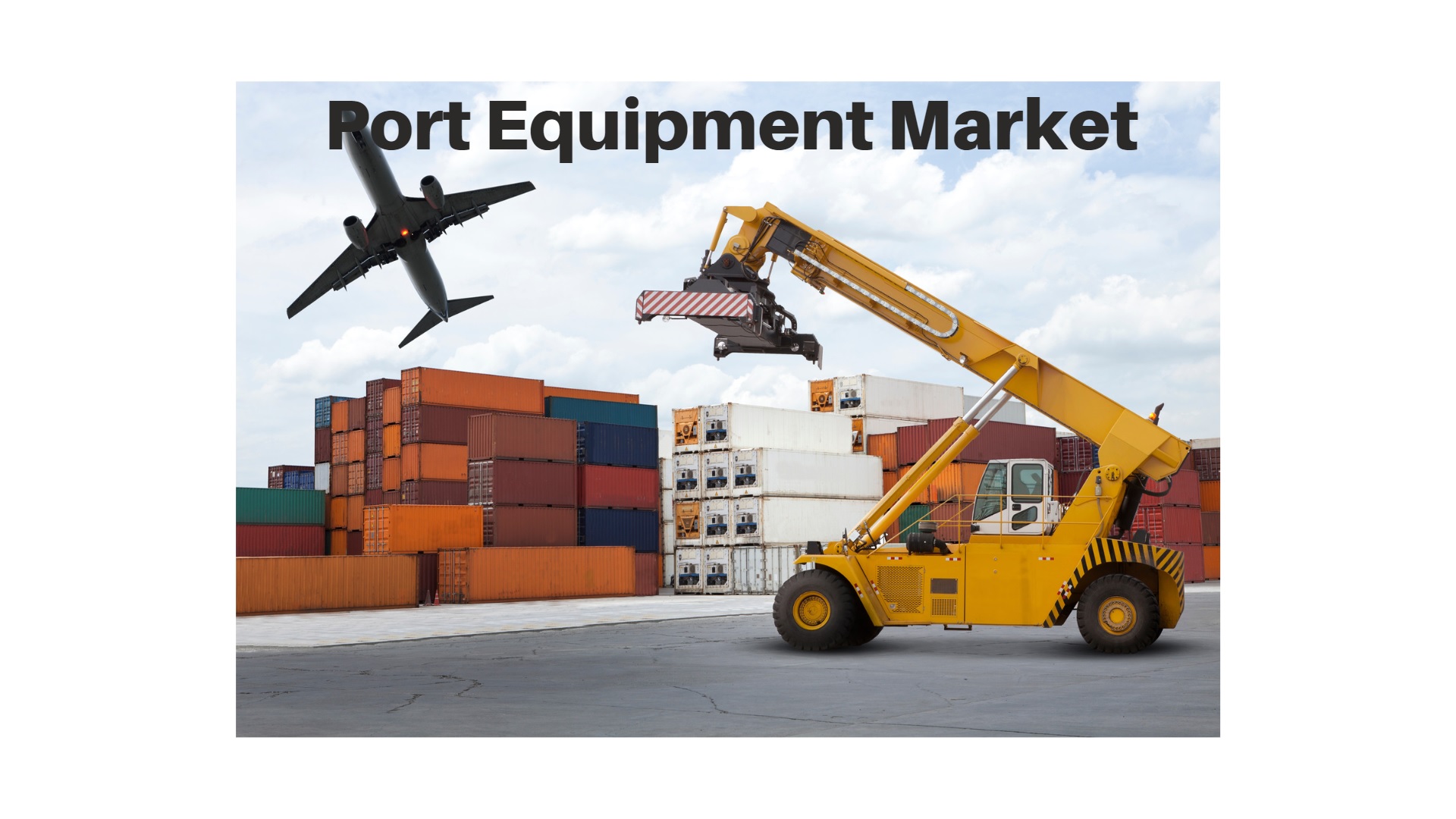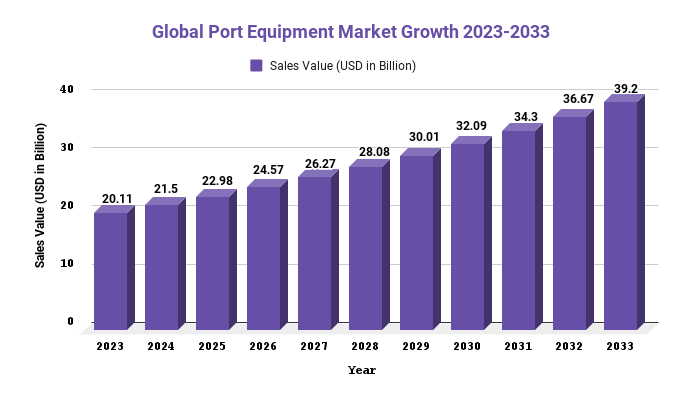Port Equipment Market will hit USD 39.20 Bn by 2033 | Growth rate (CAGR) of 6.9%

Page Contents
Market Overview
Published Via 11Press: The Port Equipment market encompasses machinery and equipment used in ports and harbors for various operations such as cargo handling, container handling, and other related activities. Forecasts indicate the market for port equipment will expand steadily over the coming years due to factors such as increased global trade volume, expanding containerization of goods, and growing demand for efficient and automated port operations.
The Global Port Equipment Market size is expected to reach USD 39.20 Bn by 2033, up from its current value of USD 20.11 Bn in 2023, growing at an annual compound growth rate (CAGR) of 6.9% from 2023-2033.
The port equipment market is divided by product type, such as container handling equipment (ship-to-shore cranes, rubber-tired gantry cranes, and straddle carriers), yard handling equipment (reach stackers and forklifts), terminal tractors, trailer carriers, and automated guided vehicles Recently, there has been an increasing trend toward automation and digitalization in port operations. This has resulted in the development of advanced equipment and systems such as automated container terminals and smart port solutions. This trend is forecast to continue over the coming years, further fueling growth within the port equipment market.

Key Takeaways
- The global port equipment market encompasses all of the equipment used for cargo handling in ports, such as cranes, forklifts, loaders and other machinery. Forecasts indicate this market will experience significant growth over the coming years due to rising global trade and an increasing need for efficient cargo handling. Factors such as e-commerce growth, increased container traffic, and larger vessels are anticipated to fuel this expansion of port equipment sales.
- Container handling equipment, such as container cranes, straddle carriers, and reach stackers, is the largest segment in the port equipment market due to the growth of containerization in global trade. Automation and digitization within shipping are propelling innovation within this sector; automated container terminals are becoming more commonplace and data analytics and other digital technologies are being employed more frequently in port operations. Environmental concerns like air pollution and carbon emissions have become more relevant in port operations; therefore there is an increasing demand for more eco-friendly equipment like electric or hybrid cranes and forklifts.
Request For Sample Report Here: https://marketresearch.biz/report/port-equipment-market/request-sample/
Regional Snapshot
The port equipment market is a global industry driven by the need for reliable cargo-handling tools that offer efficiency and dependability.
- North America: The port equipment market in North America is being driven by the growing logistics sector, which is a major source of demand for port equipment. The United States leads this region's port equipment market share, followed by Canada and Mexico.
- Europe: The port equipment market in Europe is driven by the expansion of the shipping industry, which serves as a major factor for demand for this equipment. The United Kingdom, Germany and France are three of the biggest markets for this equipment within Europe.
- Asia Pacific: The port equipment market in Asia Pacific is driven by the expansion of manufacturing, which creates a major demand for port equipment. China leads this region's port equipment market followed by Japan, South Korea, and India.
- Latin America: The port equipment market in Latin America is being driven by the expansion of the logistics sector, which is a major source of demand for port equipment. Brazil is currently leading this equipment market followed by Mexico and Argentina.
- Middle East and Africa: The port equipment market in the Middle East and Africa is driven by growth in the shipping industry, which serves as a major driving force for demand for this product. Countries such as United Arab Emirates, Saudi Arabia, and South Africa are three of the biggest markets for this product within these regions.
Inquire Here & Query for the report: https://marketresearch.biz/report/port-equipment-market/#inquiry
Drivers
- The rising global demand for goods has triggered an explosion in trade activities, necessitating the need for more efficient and productive port equipment to handle growing cargo volumes. Seaport expansion around the world has further compounded this need, necessitating modern, advanced machinery to handle these increased loads. Modern technologies have enabled manufacturers to manufacture more effective, productive port equipment – helping reduce operational costs while improving port productivity overall.
- Governments around the world are investing heavily in developing their port infrastructure, leading to an increasing need for port equipment to handle increasing cargo volumes. To reduce carbon footprint and enhance sustainability in port operations, government officials have adopted eco-friendly and energy-saving equipment – leading to an elevated demand for environmentally sustainable port equipment. Furthermore, automation of port operations has become essential to improve efficiency and productivity at ports; thus there has been an uptick in automated port equipment like automated stacking cranes, guided vehicles, and mooring systems.
Restraints
- Port equipment such as cranes, forklifts, and loaders require a significant upfront investment which may prove prohibitive for smaller ports or those with tight budgets. Ports located in remote areas may have difficulty accessing the most modern port equipment due to cost and transportation limitations. Furthermore, ports must comply with stringent environmental regulations which could increase costs and limit what types of machines can be used in certain regions.
- Port equipment requires regular upkeep and repair, which can be expensive and time-consuming. Port equipment operations can be hazardous if proper safety protocols aren't followed; this could result in accidents or injuries which have both human lives as well as financial losses. Furthermore, competition from other modes of transport such as rail and trucking has limited growth within this market, since some cargo may be transported via other methods instead of through ports..
Opportunities
- The need for increased efficiency and productivity in port operations is driving the demand for automation technologies. Equipment such as automated stacking cranes, guided vehicles, and terminal operating systems are increasingly being employed to enhance operational effectiveness and reduce costs. Containerization of goods has become more popular due to its numerous advantages – easier handling, quicker transit times, lower transport expenses – which has driven up demand for container handling equipment like container cranes, straddle carriers, and reach stackers.
- The expansion of seaborne trade is a major driver for the port equipment market. Ports are now handling larger volumes of cargo, necessitating larger and more advanced equipment to handle them efficiently. Governments and private investors are investing heavily in port infrastructure to boost capacities and boost efficiency. This presents opportunities for equipment manufacturers and service providers who provide supplies for port construction, maintenance, and operations.
- The port equipment market is rapidly developing, with new technologies designed to enhance efficiency and lower operating costs. Manufacturers and service providers can capitalize on these opportunities by developing and providing cutting-edge products and services tailored to port operators' evolving needs.
Challenges
- The port equipment market is highly competitive, with several manufacturers competing for a share in the pie. This can lead to pricing pressures and reduced profit margins. Furthermore, due to rapid technological advancements, manufacturers must continuously innovate and upgrade their products in order to stay ahead of competitors – an endeavor that may prove expensive or time-consuming. Furthermore, port equipment requires large investments for acquisition or maintenance costs which makes entry into this sector difficult for smaller players who wish to compete against larger, established players.
- The port equipment industry is under increasing pressure to reduce its environmental impact. To do this, companies must invest heavily in research and development as well as make changes to manufacturing processes. The COVID-19 pandemic highlighted the vulnerability of global supply chains; disruptions in raw material supply, component supply, or finished product deliveries can cause delays and raise costs for manufacturers. Safety remains a paramount concern within the port equipment sector; manufacturers need to guarantee that their equipment meets stringent safety requirements, plus ensure operators receive training on using it safely; any accidents or incidents could damage their reputation and lead to costly legal action from legal authorities.
Market Segmentation
Segmentation by Equipment Type:
- Cranes
- Reach Stackers
- Ship Loaders
- Automated Guided Vehicles (AGVS)
- Terminal Tractors
- Container Lift Trucks
- Tug Boats
- Forklift Trucks
- Mooring Systems
- Straddle Carriers
- Others
Segmentation by Type:
- Electric
- Hybrid
- Diesel
Segmentation by Application:
- Ship Handling
- Bulk Handling
- Container Handling
- Others
Key Players
- TTS, LLC
- Liebherr-International AG
- Kalmar, Inc.
- SANY GROUP Co., Ltd.
- Konecranes Inc.
- Hyster Company
- Shanghai Zhenhua Heavy Industries Co., Ltd.
- Lonking Holdings Limited
- CVS Ferrari SrL
- Anhui Heli Co., Ltd.
Report Scope
| Report Attribute | Details |
| The market size value in 2023 | USD 20.11 Bn |
| Revenue forecast by 2033 | USD 39.20 Bn |
| Growth Rate | CAGR Of 6.9% |
| Regions Covered | North America, Europe, Asia Pacific, Latin America, and Middle East & Africa, and Rest of the World |
| Historical Years | 2017-2022 |
| Base Year | 2022 |
| Estimated Year | 2023 |
| Short-Term Projection Year | 2028 |
| Long-Term Projected Year | 2033 |
Recent Developments
- Automation and digitalization in port equipment have grown dramatically over the past decade, including automated container terminals, remote-controlled cranes, and automated guided vehicles (AGVs), for transporting cargo. Recently, there has been an accelerating shift towards electrification within this market due to concerns around emissions and sustainability; electric-powered cranes, trucks, and other pieces of equipment are becoming more commonplace at ports worldwide.
- Recent mergers and acquisitions in the port equipment market include Kalmar Industries by Cargotec Corporation and Konecranes' Material Handling & Port Solutions business combined with Terex Corporation. The rapid expansion of emerging markets such as China and India has necessitated increased investment in port infrastructure and equipment. Leading port operators like DP World and APM Terminals have significantly boosted their operations there in recent years. Recently, the port equipment market has seen an increasing focus on sustainability with companies investing in cleaner and more efficient equipment. This includes using electric or hybrid-powered machines as well as developing new technologies to reduce emissions and boost efficiency.
Key Questions
1. What is the Port Equipment Market?
Port equipment refers to any machinery used in ports, such as cranes, forklifts, terminal tractors, reach stackers, and straddle carriers for loading or unloading cargo from ships. This market comprises more than just cranes; it encompasses other items too!
2. What are the major drivers of the port equipment market?
Global trade growth, increasing containerization of cargo, expansion, and modernization of port infrastructure, as well as rising demand for automation and digitalization within this industry are some of the primary influences driving growth in this space.
3. What are the major segments of the port equipment market?
Major segments in this space include cranes (ship-to-shore, gantry, mobile, and tower cranes), forklifts, terminal tractors, reach stackers, and straddle carriers among others.
4. What are the major challenges confronting the port equipment market?
The major difficulties experienced by this industry include competition from low-cost Chinese manufacturers, an ever-evolving regulatory landscape, environmental concerns, and a shortage of skilled labor to operate and maintain equipment.
5. What are the growth prospects in the port equipment market?
Port equipment market prospects include increased demand for automation and digitalization, expanding port infrastructure in emerging markets, as well as rising investments in green port technologies.
Contact us
Contact Person: Mr. Lawrence John
Marketresearch.Biz (Powered By Prudour Pvt. Ltd.)
Tel: +1 (347) 796-4335
Send Email: [email protected]
The team behind market.us, marketresearch.biz, market.biz and more. Our purpose is to keep our customers ahead of the game with regard to the markets. They may fluctuate up or down, but we will help you to stay ahead of the curve in these market fluctuations. Our consistent growth and ability to deliver in-depth analyses and market insight has engaged genuine market players. They have faith in us to offer the data and information they require to make balanced and decisive marketing decisions.



